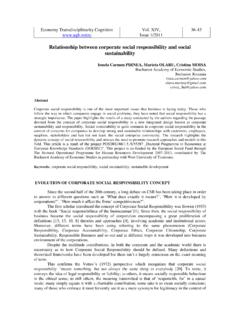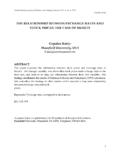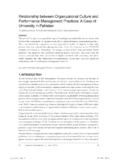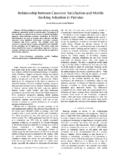Transcription of Effective customer relationship management of …
1 Journal of management and Marketing Research Effective customer relationship management of health care: a study of hospitals in Thailand Bunthuwun Laohasirichaikul Siam University Sirion Chaipoopirutana Assumption University Howard Combs San Jose State University ABSTRACT. This article investigates the effects and the relative importance of the four perceived service quality dimensions on corporate image, customer satisfaction, and customer loyalty. To obtain results, factor analysis and multiple regression techniques are applied to data collected from 500 Thai outpatients of the five largest private hospitals in Bangkok. The findings indicate that the four dimensions significantly affect corporate image, customer satisfaction, and customer loyalty.
2 More specifically, the doctor concern dimension is the most important factor affecting customer satisfaction and customer loyalty. The tangibles dimension is the most important factor affecting corporate image. Keywords: health care, relationship management , Thailand, corporate image, service quality Effective customer relationship management , Page 1. Journal of management and Marketing Research INTRODUCTION. The healthcare industry in Thailand is highly competitive as it has opened to the private sector (Hasin, Seeluangsawat, and Shareef, 2001). At present, the competition is even more intense given the high market value of the Thai healthcare industry. This has forced private hospitals to compete with each other to gain as much market share as possible.
3 As a result, many private hospitals are more emphasizing more on marketing to compete for an increased market share ( , 2008a). In Thailand, total market value of all private hospitals in 2006 was over 49,000 million baht ($ billion) and this business is both globalizing and growing rapidly ( Com, 2008). Private hospital has high potential in serving patients in Bangkok as the proportion of private hospitals in Bangkok accounted for of health care in 2005 ( , 2008). Outpatients are the majority of private hospital's customers accounting for of total patients or million in 2006 ( , 2008). For these reasons, this study focused on Thai outpatients of private hospitals in Bangkok. Corporate image, customer satisfaction, and customer loyalty may help service companies to compete in this highly competitive environment.
4 As corporate image will play an increasingly important role in this environment of increasing competition and identical service offerings by attracting and retaining customers (Andreassen and Lindestad, 1998). In addition, customer satisfaction is considered by healthcare providers as a key component of strategy and a significant determinant of long term viability and success under competitive situation (Andaleep, 1998). Moreover, maintaining and expanding customer loyalty is significant for any service company's long term success (Kandampully, 1998). The delivery of consistently superior service quality has become a very important prerequisite for many companies success (Parasuraman, Zeithaml, and Berry, 1988) because it affects corporate image (Nguyen and LeBlanc, 1998), customer satisfaction (Lee, Lee and Yoo 2000), and customer loyalty (Bloemer, Ruyter, and Wetzels, 1999).
5 Accordingly, the improvement of perceived service quality will enhance corporate image, customer satisfaction, and customer loyalty. As a result, the company can effectively compete and succeed in an increasingly competitive environment. For the measurement of perceived service quality, this study applied perceived service quality using four dimensions ( , doctor concern, staff concern, convenience of care process, and tangibles) from Choi et al. (2005) which is modified from the original dimensions of SERVQUAL (Parasuraman et al., 1985, 1988). Although there is the criticism on SERVQUAL. that it focuses only on measuring service process (Gr nroos, 1990; Mangold and Babakus, 1991), it is appropriate for healthcare service because customers (the patients) are unable to evaluate technical quality.
6 Therefore, their evaluations are based on service process or functional quality (Friedman, 1979). LITERATURE REVIEW. Brand loyalty requires both psychological and behavioral measurements (Knox and Walker, 2001). Brand loyalty is conceptually identified as the biased ( non-random), behavioral response ( buy), expressed over time, by some decision making unit ( individual, family, or company), with respect to one or more chosen brands out of a set of such brands ( considering a set of brands before selecting in and selecting out particular Effective customer relationship management , Page 2. Journal of management and Marketing Research brands), and is a function of psychological process ( decision making, evaluative process) that is developed to some degree of commitment toward a brand or multi-brands by consumers.
7 The commitment is a significant factor in distinguishing brand loyalty from simple repeat purchase behavior (Jacoby and Kyner, 1973). Similarly, customer loyalty is defined as a very strong commitment to repurchase or re- patronize a preferred product or service consistently in the future and a resistance in switching brand, although having powerful situational influences and marketing efforts (Oliver, 1999). In addition, Oliver (1999) suggested that true brand loyalty exists when all three decision making phases: (1) beliefs (cognitive); (2) affect (affective); and (3) intention (conative), are pointed toward a single brand preference. Cognitive loyalty occurs when consumer belief in one brand is preferable to alternatives because of the knowledge and/or the information about brand attributes.
8 Affective loyalty occurs when the consumer likes and has good attitudes toward one specific brand. At this stage, the consumer has both cognition and affective loyalty in his/her mind. Conative loyalty occurs when consumer has behavioral intention toward a specific brand. Oliver (1980) found that customer satisfaction can be affected by expectation and disconfirmation. Expectation is seen as an adaptation level or a reference point used to compare actual performance with the perceived performance. The comparison resulted in disconfirmation. If perceived performances are higher than the reference point (expectation), it results in positive disconfirmation. If the perceived performances are lower than the expectation, it results in negative disconfirmation.
9 These disconfirmation effects will make the post-decision deviate from the adaptation level. Then, the total effects cause customer (dis)satisfaction. Ross et al. (1987) concluded that patient (dis)satisfaction is the result of an interaction between expectations and perceived performance of service. If the patient has a positive expectation and it is substantially disconfirmed by perception of poor service performance, then the patient will be dissatisfied. The opposite is also true. Oliver (1981) defined customer satisfaction as an evaluation of the surprise inherent in a product acquisition and/or consumption experience . Parasuraman, Zeithaml, and Berry (1988). found that satisfaction is related to a specific transaction, whereas, service quality is a global judgment relating to the service's superiority.
10 Similarly, Patterson (1993) found that consumers compare between perceived performance (P) and prior expectation (E), which results in negative confirmation (when P<E), confirmation (when P=E), and positive confirmation (when P>E). Negative confirmation often tends to lead to a customer 's dissatisfaction. Confirmation is likely to lead to customer (merely) satisfaction. Lastly, positive disconfirmation tends to lead to a greater level of customer satisfaction. Gr nroos (1984) discovered that corporate image is extremely important for service organizations because customers can typically see the firm and its resources when they use service as it requires an interaction of customers with the service providers. He found that the corporate image forms as a result of how customers perceive the components of the firm that they can see.

















